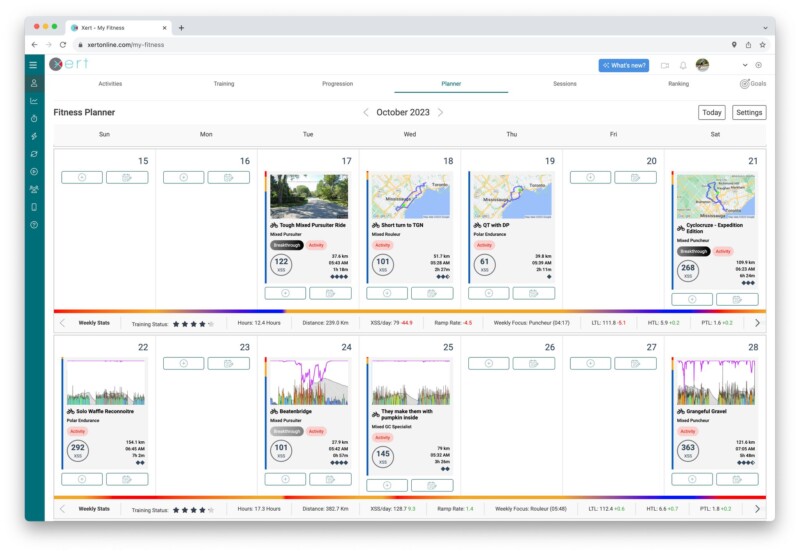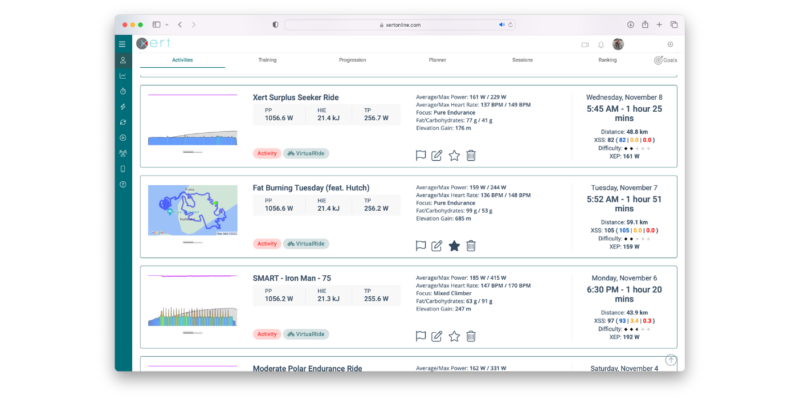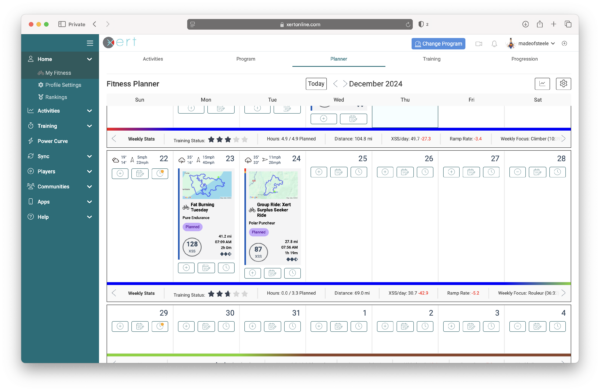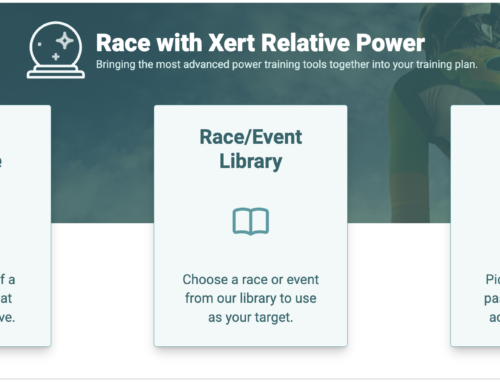New Concepts in Fitness Planning
Over the years, many users have asked about Xert-based training programs. They’ve appreciated the innovative ways we measure fitness but often wonder how to apply this information to improve their performance and prepare for target events. When designing our training planner, we didn’t want to follow the conventional, one-size-fits-all methods based on outdated textbooks or biased interpretations of research—think of the ongoing debate between Polarized vs. Sweet Spot training methods.
Instead, we wanted to harness the data-driven insights from Xert’s platform, combining them with your unique performance metrics to drive a personalized training program. This is the first step toward fully automated, adaptive training that helps you optimize your fitness. The Xert Fitness Planner has been updated to include more features, with more improvements on the way!

The Xert Fitness Planner Helps You Answer These Key Questions:
- Will my training program actually work?
- What happens if I increase or decrease intensity?
- How does changing my training time impact my fitness?
- Is my plan too hard or too easy for me?
- How can I make the most of my training time?
- What training methods will work best for me?
The Fitness Planner as a Coaching Tool
The updated Xert Fitness Planner is an essential tool for coaches, offering a quantifiable approach to the art of training optimization. Coaches often rely on field results and research to create effective plans. However, much of coaching has been intuitive, based on years of experience and understanding individual athlete variations.
With the Xert Fitness Planner, coaches can now access objective, data-driven insights that reveal the unique responses each athlete has to training. Xert can help reinforce existing practices or highlight new opportunities for improvement that may not have been obvious. It’s like having an experienced coach’s insights available at your fingertips.
The Fitness Planner for the Self-Coached Athlete
Many athletes want to move beyond generic training plans and create a personalized training program similar to what a coach would design. The Xert Fitness Planner empowers you to be your own coach. It allows you to build and manage a training plan that’s tailored to your unique fitness level, strengths, weaknesses, available training time, and ability to handle varied intensities.
By spending a little time understanding Xert and its Fitness Planner, you can raise the bar for your self-coached training. It offers the same kind of data-driven insights an experienced coach would use to manage an athlete’s progress and goals.
New Feature: Forecast AI Training Plans
In October of 2024, we introduced Xert Forecast AI (XFAI) training plans! These advanced, adaptive plans take your personal fitness signature and future goals into account to set your training load, intensity, and recovery. Unlike traditional training plans that follow a rigid structure, Forecast AI adapts to your riding – indoors or out, and structured workouts or free-rides – ensuring a flexible training plan that also keeps you on track toward your personal fitness goals!
Learn more about how these plans work and how they can optimize your training by visiting our posts on Forecast AI Training Plans.
Creating Your Own Fitness Plan
Before you start creating your plan, make sure your Xert account is properly set up:

- Ensure Your Data is Accurate – Make sure you have sufficient historical data in Xert. If your data is sparse or contains errors, it can affect the accuracy of your fitness analysis. Add missing data and contact our support team if you’re unsure.
- Keep Your Data Up-to-Date – Xert uses your current data to determine how you respond to training. Missing rides can mislead your calculations, so ensure you’re keeping everything current.
- Include Non-Power Data – Don’t forget to include rides or activities where you didn’t have a power meter, such as commutes or rides with other metrics. This ensures a complete picture of your training history.
- Review our guide on how to do that, here.
Factors to Consider When Planning Your Program:
- How much time do you have for training each week?
- How much time can you dedicate on any given day?
- What will your Training Status be on any given day?
- How far is your Target Event Date?
These questions help you determine what workouts or activities to include in your training plan. As your fitness evolves, your plan will adapt, allowing you to maximize every session. Xert’s predictive features make it the only tool capable of forecasting how your fitness will change based on your training history.
Simple 1-2-3-4 Steps to Planning Activities
Whether you’re a coach or a self-coached athlete, creating a custom plan with Xert’s data is easy. Here’s how you can get started:
Step 1: Like Structured Workouts That You Will Be Scheduling Most Often
The Xert Fitness Planner allows you to quickly add favourite workouts and activities into your fitness planner to help anchor your training program. You can head to Training > Workouts page and sort/filter the listing (use Standard, Coach or your own Personal Workouts) and give a thumbs up to a variety of workouts by clicking the ‘thumb up‘ icon next to the workout.

Step 2: Favourite Your Planned Rides/Activities and Races
Using the Activity Dashboard or Activity Table, click the ‘star‘ icon to favourite activities that are similar to those you expect to be doing again in the future. These might be a weekly group ride, commutes, cycling training camps, races, etc.

Step 3: Plan Anchor Activities
“Anchor” activities are ones that won’t change in your plan. Generally these are rides, trips, or races that everything else needs to work around. For example, for next few week, we’re going to block off Tuesday Morning for a “Fat-burning” endurance ride and Wednesday morning for our Xert Surplus Seeker Group Ride:

Note: Although you may be thinking that you should be planning out all the way to your Target Event Date, this won’t be necessary as things will be more dynamic as you execute the plan.
Step 4: Plan your Structuring Workouts / Activities
To plan your own training plan without using the Xert Adaptive Training Adviser, follow these basic rules:
- Don’t schedule anything (or at most a Recovery workout/ride) on Very Tired days with red stars
- On Tired days with yellow stars, try and schedule endurance training workouts/rides only.
- On Fresh / Very Fresh days, go ahead a schedule a greater intensity or higher XSS workout at your Suggested Focus or close to it. Your Weekly Focus doesn’t necessarily have to be identical to the Suggested Focus although the closer you get to your Target Event Date, the stricter you should maintain this Focus.
- Pay attention to your forecasted Training Status and look for workouts that have a Difficulty Rating (in diamonds) at or above your Training Status (in stars). This can help you perform workouts with an appropriate difficulty level for your stage in training.
- Manage your Ramp Rate. Ideally this should be between 1 and 7 (green in colour), with 1 representing a “Light” program and 7 representing an “Aggressive” program. A red value may mean you’re overreaching and should be avoided over extended periods. Blue values may mean insufficient amount of training time or intensity, perhaps showing a plateau.
Final Monthly Plan:

Using the Fitness Planner with Xert’s Workout Players
Xert automatically prepares your scheduled workouts for you. Whether you use the Xert EBC app for iOS or Android, or the Xert Workout Player for Garmin ConnectIQ, your workouts will be ready to go 30 minutes before the scheduled time. Just launch the app, and your workout will be waiting for you!
Advanced Concepts – Tracking and Predicting Fitness
The Power of Breakthroughs
If you’ve been working with Xert, you’ve likely noticed how it continuously tracks and refines your Fitness Signature based on your rides and training workouts. What sets Xert apart is its ability to gather and update this data with greater precision and frequency than traditional methods, allowing you to get a more accurate picture of your fitness at any given moment.
Much like the “What’s My FTP?” data field, which estimates your FTP across a variety of rides—whether they’re steady or variable in intensity—Xert also tracks your Threshold Power along with other key fitness parameters. These parameters are part of your Fitness Signature, a comprehensive set of data points that reflect your unique ability to generate power at various intensities, including Peak Power and High Intensity Energy (HIE). Instead of relying on periodic, one-time tests to estimate these values, Xert continually updates all of these values based on all of your rides!

One of the most powerful aspects of Xert’s system is its use of Breakthroughs. A Breakthrough occurs whenever you perform at a level higher than your previous best effort, often identified during efforts that push you to your limit. These breakthroughs are shown as coloured circles on Xert’s Progression Charts. Each breakthrough provides new data points that refine your Fitness Signature by pinpointing your highest sustainable effort at any given time.
How Xert Analyzes Your Breakthroughs and Training Loads
Xert doesn’t just track your data—it makes sense of it. By analyzing Breakthroughs and the patterns of training loads associated with them, Xert identifies how your training volume, intensity, and recovery affect your fitness. It looks at the relationship between these variables to fine-tune your Fitness Signature and determine the most effective way to progress. This process is built on advanced algorithms that track the patterns of improvement in your performance over time, giving you insights into how specific training loads and intensities are impacting your ability to perform.
For instance, if you repeatedly push to the limit during intervals, Xert will note the training loads and intensity levels that led to those breakthroughs and adjust your Fitness Signature accordingly. Xert then uses this historical data to predict how future training will affect your performance. There’s no magic formula here—just the power of data-driven analysis. Through basic mathematical models, Xert calculates how your fitness will evolve based on how you’ve responded to past training efforts.
Real-Time Predictions and the Fitness Planner
These predictions are displayed in the Fitness Planner, where you can visualize how your training and breakthroughs influence your future fitness trajectory. The ability to plan and optimize your training based on how you respond to training is a game-changer. Rather than following a generic plan based on assumptions or one-time tests, Xert’s system allows you to craft a personalized plan grounded in real-world data from your own performance.
The Importance of Consistent and Accurate Data
For Xert’s predictive capabilities to work effectively, it’s crucial to keep your data up-to-date and ensure that you have a consistent flow of breakthroughs with enough depth and variety. This means performing at your best during training sessions and regularly recording those maximal efforts. Without consistent and accurate data, the system won’t have the necessary information to make accurate predictions, which is why maintaining detailed and accurate ride logs is essential.
When you have a steady stream of Breakthroughs, Xert can continuously refine your fitness signature, giving you actionable insights into how your training is progressing and what adjustments are needed to optimize your performance. With this data, you and the Xert Fitness Planner can now plan to improve and optimize your fitness in ways that were previously impossible, ensuring you’re always working toward your true potential.
Conclusion
Xert’s ability to track and analyze your fitness signature in real-time, based on breakthroughs and training loads, allows you to plan and optimize your training like never before. By using your own data to predict performance and refine your fitness, Xert ensures that every workout is tailored to your unique capabilities. With continuous, data-driven insights, you can take your training to the next level, achieving measurable improvements and optimizing your fitness progression with unmatched precision.
Updated 19 Dec 2024





